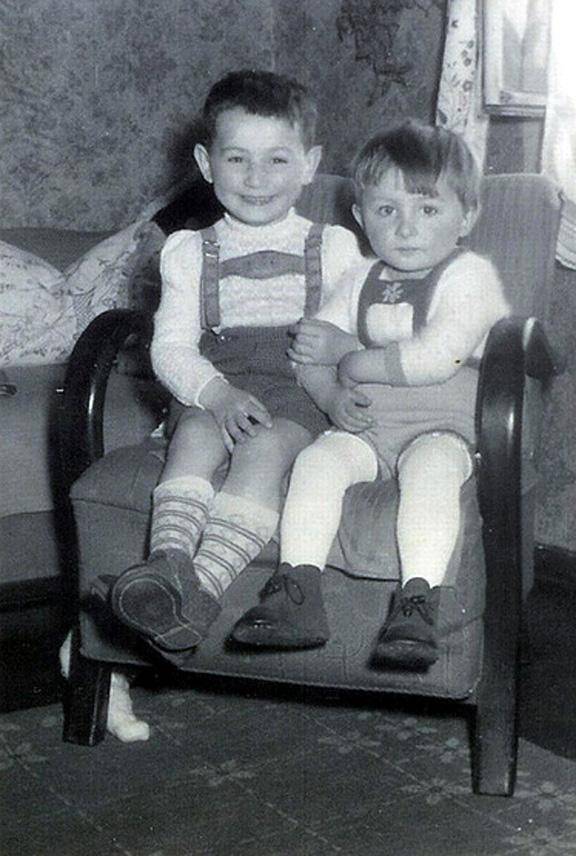
German Stocking Supporters: Types

Figure 1.--These German brothers look to be about 2 and 4 years old. Both of the boys wear short pants, but not Lederhosen with halter tops. The older boy wears striped knee socks, while the younger one wears white long stockings with supporters. One interesting feature that seems somewhat unusual is the use of double-pendant hose supporters for the white stockings that resemble those that would be common in the United States rather than the single strap garters that were usual on German Leibchen. You can clearly see the rubber buttons (two on each leg) that show by their position close together and in front on each leg that they are garters of the American
type and probably pinned-on or sewn-onto to an underwaist or bodice. Notice the bangs on the younger child. It looks as though mother cut her boys' hair at home. The photograph is dated 1931, but we know nothing else about its origin except that it is German.
|
|
German children used both dedicated garments to hold up long stockings as well as more informl approaches. The Leibchen was a an important German garment used to hold up stockings. The koselet seems to have been essentially a Leibchen. The Leibchen was similar to an American inderwaist or a British Liberty bodice. The Leibchen was commonly used in connection with garter straps to hold up long stockings. Informal approaches such as basic safty pins were a common method of holding up stockings. These informal approaches seem to have been more common than in America.
Korselett
Here we have an advertisement from an unnamed German clothing catalog dated 1940. It is referred to as a "Kinder Korselett" or child's corslet rather than a Leibchen. It coresponds, however, closely to Leibchen. The model here and the styling of the garment is clearly for a girl. Although the dimunative of corset is used, we see none of the stays that would relate this to a corset. Thus we think this may be essentially a Leibchen described with a different term., but we are not yet sure.
One garment discussed in the German clothing section was a "Leibchen"--a vest-like garment worn under a boy's shirt to which hose supporters were sewn or otherwise attached. (I don't believe the German boys had safety pins at the tops of their garters as the American boys usually did.) The Leibchen ordinarily buttoned up the back and was apparently made of some sturdy material (jean cloth?) that would take the strain of the attached hose supporters. This may be the garment which the two cyclists in your pages on German Long Stockings are wearing although one of your German contributors in "Long Stockings: Length" mentions that older boys "had shorter garters fixed at a waist belt similar to that worn by their mothers, but of course without all the adornment of women's garter belts." Note that the stockings are very long in these pictures and that the supporters fasten very high on the leg under very short shorts. Some of these Leibchens appear to have only two garters in front--one for each stocking--while others seem to have four garters--two for each stocking.
German boys' were two types of garters. One kind had button-holes on the elastic strap for fastening to a white button on the stockings. Another kind had a strap that just has the ordinary clib with rubber button and metal loop. Both types were attached to Leibchen or bodices and some of these bodices had four garters while others had only two.
Informal Approaches
Informal approaches such as basic safety pins were a common method of holding up stockings. These informal approaches seem to have been more common than in America.
HBC

Navigate the Boys' Historical Clothing Web Site:
[Return to the Main German stocking supporter page]
[Return to the Main country stocking supporter page]
[Return to the Main country underwear page]
[Return to the Main German garment page]
[Introduction]
[Activities]
[Biographies]
[Chronology]
[Clothing styles]
[Bibliographies]
[Contributions]
[FAQs]
[Glossaries]
[Images]
[Registration]
[Tools]
[Boys' Clothing Home]
Created: 7:45 PM 12/20/2010
Last updated: 7:45 PM 12/20/2010



